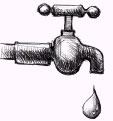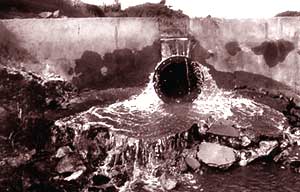Water fall-outs Industrial water use has triggered off a host of problems In developed and
developing countries alike, competition among water users is increasing. Tensions are
particularly high in water-scarce areas where domestic, agricultural and industrial water
needs are pitted against each other. In developing countries like India, where every
segment of the economy is growing rapidly, the conflict will become unmanageable if not
addressed now. Even today most big cities in India are getting piped water from far-off
places. This is putting tremendous
Depletion of groundwater by industries, supply of water meant for irrigation to industries, preferential treatment given to industries by the government are some of the major reasons for the conflict between industry and community over water use. Another major reason for this ongoing conflict is water pollution. Protest and public interest litigations have become quite common on this issue.
Villagers living downstream used the water for drinking, irrigation and other household activities. They lodged complaints such as discoloration of water, skin allergies and a decline in crop productivity due to the usage of contaminated water. The Bhavani river agitation
was marked with protests by the local community mobilised by NGOs - Bhavani River
Protection Joint Council and Lower Bhavani Projects Ryots Association. But this entire episode took its toll and the industry is currently not operational.
Sinar Mas Pulp & Paper (India) Ltd. (SMPPIL) was set up in 1997 on the Pune-Solapur highway near Pune, Maharashtra. The mill met its entire requirement from Ujjani dam. Since the imported pulp is dry, SMPPIL consumed a large quantity of water during its papermaking process and the treated effluent was discharged through a 12 km long pipeline into river Nira. The local communities in and around the region were against the mill for various reasons. To begin with, the water from Ujjani dam was originally meant for irrigation of drought-prone areas. Secondly, there was the fear that usage of water by Sinar Mas would lead to water shortage for sugarcane growers in Solapur and Indrapur, which in turn would affect the sugar co-operative factories. To make matters worse, the local community was also upset at the preferential treatment given to the industry by the government, namely, cheaper rates for tankers (it was alleged that the government was charging only Rs 3 per 10,000 litre tanker from the company whereas farmers and villagers had to pay about Rs 100 per tanker). The industry was also assured that they would be provided water from the dam for eight months. But villagers received no such assurance. As a spillover of this conflict more than 20 cases were filed against the company in various courts. The company thereafter reduced its water consumption significantly and today it is one of the lowest water-consuming paper mills in the country. It took almost five years for the company to regain confidence of the local community. Currently the mill is functioning under the name of Ballarpur Graphics Paperboards Ltd.
The Mavoor unit of Grasim
Industries is situated on the banks of river Chaliyar in Kozhikode district of Kerala. The
unit produced rayon grade pulp. The unit used to discharge its treated effluent into river
Chaliyar. Over 200,000 people live on the banks of the Chaliyar and the discharge of
effluents by the mill was one of the main reasons of conflict between the local Complaints of pollution of
river, fish deaths and lack of adequate treatment facility at the unit began pouring in.
There were also several health related complaints, such as high incidence of cancer in the
region. The committee made 28 recommendations after conducting a detailed study and interacting with the local community. The government accepted them and Kerala State Pollution Control Board gave time-bound directions to the mill in July 1998 to implement the recommendations within one year. Instead, the mill decided
it was time to close down. l |
|||||||||||
|

 Industry-community
conflict
Industry-community
conflict One of the few integrated viscose rayon manufacturers in India, SIV
Industries was established in 1964. It is situated upstream river Bhavani in Sirumugai
village of Coimbatore district, Tamil Nadu. The mill used river water and discharged its
treated effluent back into river Bhavani.
One of the few integrated viscose rayon manufacturers in India, SIV
Industries was established in 1964. It is situated upstream river Bhavani in Sirumugai
village of Coimbatore district, Tamil Nadu. The mill used river water and discharged its
treated effluent back into river Bhavani.